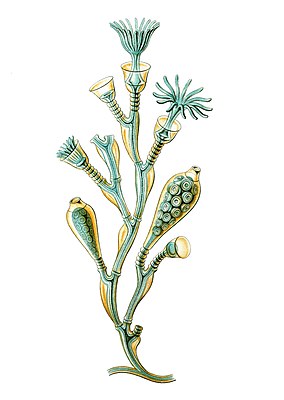Obelia
| Obelia | ||||||||||||
|---|---|---|---|---|---|---|---|---|---|---|---|---|

Obelia geniculata (middle) |
||||||||||||
| Systematics | ||||||||||||
|
||||||||||||
| Scientific name | ||||||||||||
| Obelia | ||||||||||||
| Péron & Lesueur , 1810 |
Obelia is a genus of cnidarians . Over 20 species of this genus are currently known. The polyps form colonies in which the individual animals are connected to one another by runners. The cane formation takes place either sympodially, for example in Obelia geniculata , or stolonial. A single polyp is no larger than 1 mm and is surrounded by a translucent periderm . The polyp is round and bottle-shaped, the body of which can be easily distinguished from the much thinner stem (hydrocaulus). The diaphragm is located on the ringed stem. The hydrant are surrounded by an open, chalice-shaped shell, a dimensionally stable hydrotheca with a serrated edge into which the body can completely withdraw. The tentacles of the polyp are arranged in a wreath around the mouth opening (hypostome) on the upper part and are formed at the same time.
Reproduction
The tentacles themselves are covered with nettle cells , the cnides. The reproductive cycle takes place in the metagenetic generation change typical of the Cnidaria . The medusa reproduces sexually, while the polyp reproduces asexually.
Asexual reproduction
It takes place by budding, whereby the newly created parts remain in permanent association.
Sexual reproduction
Medusa formation is also an asexual process. This initiates sexual reproduction.
In the Thecata, the medusae arise in the gonangia from lateral budding on the blastostyle. It starts with a bubble-shaped protuberance on the body wall. The young medusa plant takes on a pear-shaped shape with a thin stem. By enlarging and differentiating the entire system, which is connected with a thinning of the epithelia, and by developing the subumbrellar muscles and the velum, the medusa bud slowly reaches the stage of detachment.
The basal stalk becomes thinner and the delicate peridermal covering, which has enclosed the Medusa bud during its entire formation, is burst by swimming contractions. The young medusa can become detached and swims away. In some species, a stalk canal remains on the producer polyp, which only disappears some time after detachment. The Medusa generation is separate sexes. The gender of the medusa is already defined by the polyp, since hydroid polyps only ever produce medusa of the same sex. The free-swimming medusas now produce numerous small eggs, several 100 to 1000 depending on their size. After spawning, the medusa die. Their lifespan is therefore only a few months. The eggs are inseminated and develop into a planula in open water. The appearance of medusa of the same degree of maturity in large flocks of the same age and origin increases the insemination rate.
The larva swims in wide spirals with a coordinated flagella stroke and constant rotation around the primary body axis. At the end of the pelagic phase, the planula undergoes a metamorphosis, with the front end thickening in the shape of a pear. With the help of sensory cells, the larva finds a suitable substrate to which to attach. She also has the option to extend the larval stage if she has not found a suitable spot immediately. The process of attachment is in turn associated with a change in shape in which the larva flattens out. Then the stretching to the primary polyp takes place, at the upper end of which the mouth opening breaks and all tentacles are placed in a circle at the same time.
nutrition
The polyps are carnivorous microphages and passive lurkers. They catch their prey, which approaches them by chance or carried by the current, with their long, outstretched tentacles. The cnids, the stinging cells on the tentacles, are a help here. These react to chemical and mechanical stimuli from the prey. The rapid capture of the prey by the explosion of the nettle capsules is followed by the shortening of the tentacles that bring the prey to the mouth. This opens immediately and devours the food.
The food itself consists mainly of zooplankton, especially copepods and larvae of marine invertebrata . With the Thecata, the maximum size of the food is given by the diameter of the Theca.
Medusas, like their producer polyps, are passive lurkers and carnivorous microphages.
proof
- GRUNER, H.-E. (1993): Textbook of Special Zoology
- STARCK, JM (2005): Basic Biological Course - Zoological Part